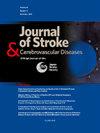The safety and efficacy of factor XIa inhibitors for the prevention of stroke and thromboembolism: A systematic review and meta-analysis of randomized controlled trials
IF 1.8
4区 医学
Q3 NEUROSCIENCES
Journal of Stroke & Cerebrovascular Diseases
Pub Date : 2025-06-19
DOI:10.1016/j.jstrokecerebrovasdis.2025.108381
引用次数: 0
Abstract
Background
Stroke and thromboembolism remain the leading causes of mortality worldwide. Factor Xia inhibitors (FXIa) might prevent thromboembolism without interfering with hemostasis, thus leading to a lower risk of bleeding than direct oral anticoagulants (DOACs).
Methods
We conducted a systematic search using PubMed, Embase, and Clinicaltrials.gov to retrieve randomized controlled trials comparing FXIa inhibitors to placebo or DOACs in patients at risk of stroke or thromboembolism. All statistical analyses were carried out using RevMan 5.4, using a random effects model.
Results
Our meta-analysis included 14 RCTs involving 30,952 patients. FXIa inhibitors significantly decreased the risk of major bleeding (RR 0.47, 95% CI: 0.33-0.66, I2= 46%) with no significant change in systemic embolism or thromboembolism (RR 0.83, 95% CI: 0.64-1.07, I2= 70%). There was no significant change between the two groups when assessing the rate of all bleeding events (RR 0.78, 95% CI: 0.55-1.11, I2= 73%), all-cause mortality (RR 0.87, 95% CI: 0.70-1.09, I2= 0%), ischemic stroke (RR 0.99, 95%CI: 0.49-1.98, I2= 86%), myocardial infarction (RR 1.30; 95% CI, 0.54 – 3.13; I² = 68%), and intracranial hemorrhage (RR 0.49, 95% CI: 0.23- 1.05, I2= 9%). The rate of all adverse events (RR 1.05, 95% CI: 0.86-1.29, I2= 79%) and serious adverse events (RR 1.16, 95% CI: 0.86-1.55, I2= 74%) remained comparable between the two groups.
Conclusion
In conclusion, FXIa inhibitors show promise as safer anticoagulant agents, demonstrating favorable bleeding outcomes without changing thromboembolism, mortality, or other safety outcomes. The presence of heterogeneity across various subgroups warrants data from further high-quality, large-scale RCTs to establish evidence of its clinical benefit. This is especially important in atrial fibrillation, where conflicting evidence regarding thromboembolism warrants cautious interpretation and further investigation.
XIa因子抑制剂预防脑卒中和血栓栓塞的安全性和有效性:随机对照试验的系统评价和荟萃分析。
背景:中风和血栓栓塞仍然是世界范围内死亡的主要原因。因子夏抑制剂(FXIa)可能在不干扰止血的情况下预防血栓栓塞,因此导致出血的风险低于直接口服抗凝剂(DOACs)。方法:我们通过PubMed、Embase和Clinicaltrials.gov进行了系统检索,检索比较FXIa抑制剂与安慰剂或DOACs在卒中或血栓栓塞风险患者中的随机对照试验。所有统计分析均采用RevMan 5.4软件,采用随机效应模型。结果:我们的荟萃分析包括14项随机对照试验,涉及30,952例患者。FXIa抑制剂显著降低了大出血的风险(RR 0.47, 95% CI: 0.33-0.66, I2= 46%),而系统性栓塞或血栓栓塞无显著变化(RR 0.83, 95% CI: 0.64-1.07, I2= 70%)。两组在评估所有出血事件发生率(RR 0.78, 95%CI: 0.55-1.11, I2= 73%)、全因死亡率(RR 0.87, 95%CI: 0.70-1.09, I2= 0%)、缺血性卒中发生率(RR 0.99, 95%CI: 0.49-1.98, I2= 86%)、心肌梗死发生率(RR 1.30;95% ci, 0.54 - 3.13;I² = 68%)和颅内出血(RR 0.49, 95% CI: 0.23- 1.05, I2= 9%)。两组间所有不良事件发生率(RR 1.05, 95% CI: 0.86-1.29, I2= 79%)和严重不良事件发生率(RR 1.16, 95% CI: 0.86-1.55, I2= 74%)保持可比性。结论:总之,FXIa抑制剂显示出更安全的抗凝药物的前景,在不改变血栓栓塞、死亡率或其他安全性结果的情况下显示出良好的出血结局。不同亚组间异质性的存在保证了进一步高质量、大规模随机对照试验的数据,以确定其临床益处的证据。这在房颤中尤其重要,关于血栓栓塞的相互矛盾的证据需要谨慎的解释和进一步的调查。
本文章由计算机程序翻译,如有差异,请以英文原文为准。
求助全文
约1分钟内获得全文
求助全文
来源期刊

Journal of Stroke & Cerebrovascular Diseases
Medicine-Surgery
CiteScore
5.00
自引率
4.00%
发文量
583
审稿时长
62 days
期刊介绍:
The Journal of Stroke & Cerebrovascular Diseases publishes original papers on basic and clinical science related to the fields of stroke and cerebrovascular diseases. The Journal also features review articles, controversies, methods and technical notes, selected case reports and other original articles of special nature. Its editorial mission is to focus on prevention and repair of cerebrovascular disease. Clinical papers emphasize medical and surgical aspects of stroke, clinical trials and design, epidemiology, stroke care delivery systems and outcomes, imaging sciences and rehabilitation of stroke. The Journal will be of special interest to specialists involved in caring for patients with cerebrovascular disease, including neurologists, neurosurgeons and cardiologists.
 求助内容:
求助内容: 应助结果提醒方式:
应助结果提醒方式:


